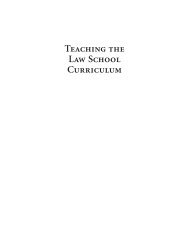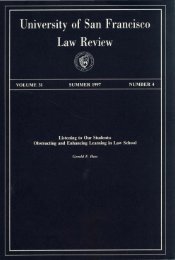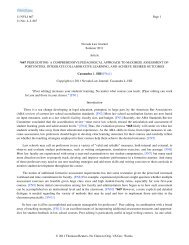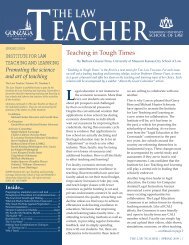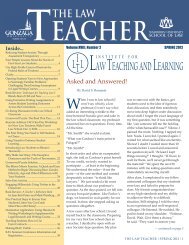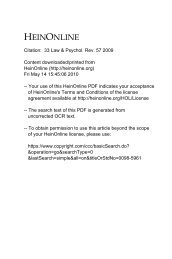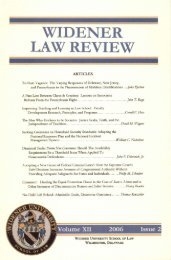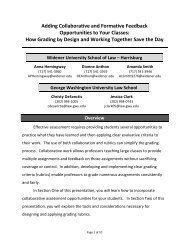The Law Teacher - Institute for Law Teaching and Learning
The Law Teacher - Institute for Law Teaching and Learning
The Law Teacher - Institute for Law Teaching and Learning
Create successful ePaper yourself
Turn your PDF publications into a flip-book with our unique Google optimized e-Paper software.
collaboration Between clinical <strong>and</strong> Doctrinal Professors <strong>for</strong> <strong>Teaching</strong><br />
First Year <strong>Law</strong> Students<br />
— continued from page 20<br />
class session to lead a short simulation<br />
exercise or small group exercise that<br />
includes negotiating, drafting, reviewing,<br />
<strong>and</strong> analyzing a contract. I have used a<br />
very simple contract drafting exercise in<br />
my clinic seminar requiring students to<br />
negotiate <strong>and</strong> draft a short contract. we<br />
then review the drafted provisions as a<br />
class <strong>and</strong> discuss what is missing in the<br />
drafting. This exercise can be done in<br />
about 45 minutes. It is a quick exercise,<br />
but sufficient to give the students a brief<br />
introduction to a contract as a living<br />
document that is a negotiated agreement<br />
between parties designed to accomplish<br />
a common goal; my students learn that<br />
contract law is not just a theoretical array<br />
of rules <strong>and</strong> constructs.<br />
alternatively, the clinician can lead<br />
the students in a small group exercise<br />
negotiating a simple business deal. It<br />
is not unusual <strong>for</strong> parties in a business<br />
deal to make subsequent agreements<br />
<strong>and</strong> amendments after a contract is<br />
executed. Leading the students in an<br />
exercise to draft short amendments can<br />
help them underst<strong>and</strong> the importance of<br />
a well-drafted contract, the importance<br />
of strategy in deal planning, <strong>and</strong> the<br />
importance of client counseling.<br />
Many clinics often have student<br />
presentations on a topic or student led<br />
classes. This approach loosely follows a<br />
‘Learn one, do one, teach one’ approach<br />
built on the idea that students may<br />
learn more effectively when their study<br />
material is rein<strong>for</strong>ced by having to do<br />
more than read. <strong>The</strong>re is a fundamental<br />
difference in learning <strong>and</strong> retention<br />
between reading a math proof <strong>and</strong><br />
having to write one. Clinicians <strong>and</strong> firstyear<br />
professors could work together to<br />
craft similar student-led exercises <strong>for</strong><br />
first-year law students.<br />
<strong>The</strong>re is value in having a clinician<br />
conduct these exercises in the class.<br />
clinicians often direct these types of<br />
exercises <strong>and</strong> simulations regularly<br />
<strong>and</strong> thus, have the exercises ready <strong>for</strong><br />
implementation. In addition, clinicians<br />
might bring a more practical approach<br />
to learning that can be a useful contrast<br />
to the case-law analysis frequently<br />
used in first-year courses. Non-clinical<br />
professors frequently guest lecture in<br />
clinical seminars on specific topics <strong>and</strong><br />
we, as clinicians, could do the same.<br />
clinical <strong>and</strong> non-clinical professors can<br />
make an ef<strong>for</strong>t to work together to find<br />
at least one or two classes, even if the<br />
classes are review classes at the end of<br />
the semester, to help our students bridge<br />
the gap between the theory, which is the<br />
ALL IN THE FAMILY<br />
Solution<br />
substance of the work we do, <strong>and</strong> the<br />
practical implementation of it <strong>for</strong> our<br />
clients. Such an approach could also be<br />
very helpful in bridging the gap between<br />
clinicians <strong>and</strong> non-clinicians in creating<br />
a more cohesive learning <strong>and</strong> working<br />
environment.<br />
____________<br />
Julie D. <strong>Law</strong>ton is assistant clinical professor<br />
at DePaul College of <strong>Law</strong>. Contact her at<br />
jlawton1@depaul.edu.<br />
S E X I S M . A F . H A S<br />
P R O M . O . M A N A G E<br />
O A R . D O M I C I L E D<br />
U S . N O N A G E . T I U<br />
S E . C U S T O D Y . S C<br />
E R A . G E R . . H O M E<br />
. . J U S T I C I A R . .<br />
S T A R . . M R S . D O E<br />
C E . U N H O U S E . T N<br />
A D R . O E N E U S . T J<br />
L I F E S T Y L E . T A O<br />
P U L L E T . T . K I W I<br />
S M P . S Y . Y E O M A N<br />
<strong>The</strong> <strong>Law</strong> <strong>Teacher</strong> | FaLL 2012 | 21




